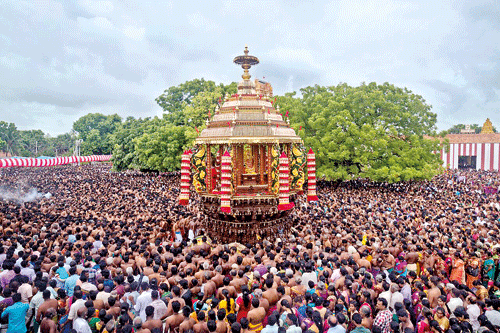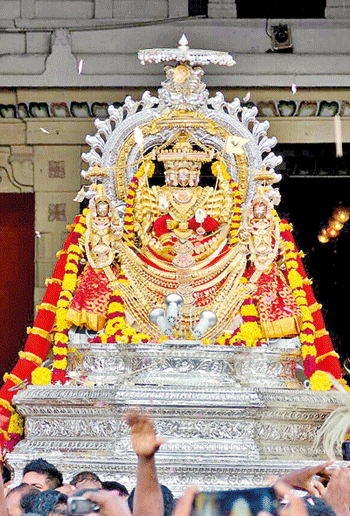When a resplendent chariot of faith kindles devotion

Chariot paraded amidst a sea of devotees. Pix by Varnan Sivanesan
As cries of ‘Haro Hara’ permeate the Jaffna landscape, lotus and rose petals cascade on statues of Lord Murugan also referred to as Skanda or God Shanmuhar seated with his consorts Valli and Deiveyani on a throne of intricate artistry. The 50 foot-tall golden-hued Chariot or ‘Ther’ receives the idols within the outer courtyard (prakaram) of the Nallur Kandaswamy Kovil (temple) and with several groups of musicians and preceded by a large colourfully embellished bell, wends its way around the outer prakarams of the kovil, parading along the streets of the temple to the timbre of Sanskrit scriptures.
Marking the end of the Ther or the Chariot Festival, later in the day Lord Murugan (to whom the Nallur Kovil is dedicated) and his consorts adorned in green, return to the main shrine showering their blessings on thousands of devotees, some who cross the shores to behold this sight of astounding devotion and cultural resplendence.
Nallur Kandaswamy Kovil is synonymous with its Mahotsvvam (grand festival) which unfolds over 25 days, commencing with the flag-hoisting ceremony (kodiyetram) six days after the new moon of Aadi – the Tamil month of July, usually around the latter part of July or early part of August each year. Followed by a string of festivals including the Manjam, Karthikai, Kailasavahanam, Velvimanam, Thandayuthepaniuthsavam and Sapparam, the culmination of the celebrations is Ther or the Chariot Festival. This year it will parade the streets of the kovil on August 20.
On the eve of the chariot festival is the Sapparam festival where embellished deities are placed on a structure known as sapparam which is a flat illuminated chariot annually constructed and later dismantled. It is recorded as the country’s tallest mobile structure.
“Although there are no confirmed records, it is assumed that the festivities were introduced to the temple during the period of the temple’s third custodian, Arumuga Maapana Mudliyar the 1st in the latter part of the 18th century. Annual festivals are all about coming together of people, villages and even diverse cultures. Ritualistically, the Mahotsvam symbolizes the three sacred acts of God which are creation, destruction and protection, denoted by the flag hoisting ceremony, the Chariot Festival and the water-cutting ceremony respectively,” explains Shayan Kumaradas, whose father, Kumaradas Maapaana Mudliyar is the present custodian (10th custodian down the line). Shayan is co-administrator of the kovil.
The sequence of poojas and rituals preceding the Chariot Festival denotes the cyclic nature of the karma theory which completes its full circle with the destruction of one’s own evil and the purification of the soul to commence the next cycle. “Getting created is not within our control but getting rid of our own evil or sins is very much within ours. Lord Murugan coming in his chariot to kill this evil within us is followed by the water cutting ceremony which denotes protection over this cleansed soul,” explains Shayan.
The throne or the simhasana on which Lord Murugan is ushered is seen by the devotees only once a year at the chariot festival. Arumuga Maapana Mudliyar the 2nd who is credited for the “renaissance” of the Nallur Kovil as the 7th custodian at the turn of the 19th century, was a wealthy merchant who invested his riches in the temple. One of his most noteworthy contributions was this silver throne for the god.
“It is done in pure silver and the intricacy of the design is what renders its uniqueness,” explains Shayan. “Not only had he brought down craftsmen from India, he had even held competitions among them to select the best silversmith. The winner had to sculpt the throne before his own eyes, the tradition which was kept alive in terms of all works of art related to the kovil.”

The silver throne in all its glory
Even when the Great New Chariot was made in 1964 it was done before the custodian Shanmugathas Maaapana Mudliyar. “The old chariot which was built during the time of the third Custodian in the latter part of the 18th Century had deteriorated by this time and the new one which replaced it, is maintained to date in ‘mint condition’ as Shayan points out. It is maintained by able temple staff trained under the skilled craftsmen of yore. History says that one Puvaneya Vaaku (‘The one with his victorious shoulders’ in Tamil ), a minister to the first Aryachakrawarthi King of Jaffna- Kalinga Magha first erected a Nallur Kandaswamy Kovil way back in the 13th century. Sapumal Kumaraya also known as Chempaha Perumal who ruled the Jaffna Kingdom as an agent of the Kotte monarch is believed to have expanded the kovil in the 15th century. In 1620 when the Portuguese warrior Philip de Oliveira plundered Jaffna, the kovil was reduced to rubble. It was only in 1734 under Dutch occupation that a shroff at the Dutch Kachcheri, Don Juan Ragunatha Maapana Mudliyar the 1st influenced the colonial masters to let him ‘resurrect’ the kovil. A property was brought by ‘Don Juan’ close to his home, (which still remains the ancestral home of his descendants) and a thatched roofed mud hut erected to deposit the Vel, the revered symbol of Lord Murugan.
Since its Spartan reconstruction, Nallur Kovil had seen it all including great work of artistry, an iron-willed female custodian who ‘ran the show behind the curtain’ mentoring her sons and grandsons as future custodians and a ravaging civil war through which the sacred grounds became an oasis.
“Being a liberal man my grandfather, the 8th Custodian, introduced the system of archanai pooja offered to anyone at one rupee ensuring equality and affordability,” explains Shayan. Hence there is no space for ‘VIP treatment’, ‘caste discrimination’ or any commercial ventures on the sacred grounds, he adds.
The temple works on a system of ‘checks and balances’ and assures impeccable time management and discipline. Earning a reputation for his ‘simplicity’ and managing the kovil during the most turbulent periods, the present custodian, Kumaradas Maapaana Mudliyar ensured that the festivities of the Mahotsvvam were carried out even at the peak of the conflict, yet on a much subdued scale. He is also credited for fortifying the kovil and making it the largest Hindu kovil complex in the country.
It is also a labour of love, devotion and a life-time commitment by those who are born to serve the grounds touched by the grace of gods and supported by ardent devotees. For both the Hindu and the non-Hindu, there is reverence and ample space for inspiration in the ritual. Nallur Kovil with its golden-pillar supported inner halls, four gopurams, six bell towers and the sacred pond in the inner precincts is watched over by Lord Murugan whose grace is not confined to the magnificent shrine but living in the hearts of the rich, poor, young and the old….


